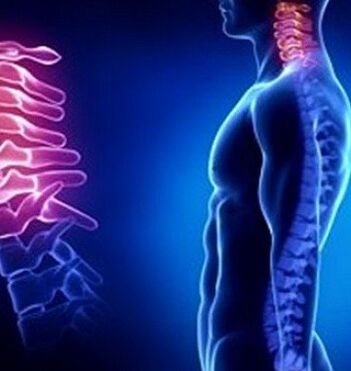
With osteonecrosis, there is a gradual destruction of the tissues of the spine, which leads to a violation of its function. Usually such degenerative processes develop in its most mobile parts. In young people, cervical osteonecrosis is most often observed. The instability of this part, combined with increased physical activity, accounts for the vulnerability to injury and various dystrophic processes. Out of 10 cases, 3 cases, it is he who causes sudden headaches. Osteochondrosis causes metabolic disorders in the spine. Because of this, the discs in it protrude, and then crack.
Symptom
Several signs may indicate dystrophic changes in the spine. Depending on the stage of the disease, they are more or less obvious. Cervical fibroids have the following symptoms:
- Neck, back, shoulder pain. Reinforced even under light loads.
- Numb hands and feet.
- Breaks when turning the neck.
- Headaches are localized mainly in the occipital and temporal regions.
- Fainting, chronic fatigue.
- Noise in the ear, hearing loss.
- Reduced eyesight.
Cervical fibroids can also be indicated by traction pain in the heart area. Patients often experience sensations similar to those of angina. When the spinal roots are compressed, other disorders also occur. For example, loss of sensation of the tongue or decreased tone of the neck muscles, breathing problems. If treatment is not indicated in time, the patient may develop protrusion or hernia.
There are four stages of osteonecrosis. The first is characterized by instability in the intervertebral discs. Regarding the second, protrusions are considered the main sign. In this case, the spaces between the vertebrae become smaller. There is pain syndrome, possibly related to a pinched nerve root.
In the third stage, destruction of the annulus, an integral part of the disc, occurs. That's why it then deforms. Patients with fourth stage cervical osteonecrosis feel severe pain with any movement. It should be noted that a decrease in its intensity does not indicate a recovery. On the contrary, this suggests that the process of forming osteoblasts connecting the vertebrae has begun. As a rule, this leads to disability. Treatment is prescribed based on clinical signs and stage of development of the pathology.
Cause of disease

Sedentary work often accompanies cervical osteochondrosis. This part of the spine is quite compact, and so even slight muscle strain can lead to compression of nerve endings and blood vessels. In that context, osteoblasts often form, which only makes the situation worse. In addition to a sedentary lifestyle, the disease can be triggered by:
- metabolic disorder;
- Malnutrition;
- salt deposition in the cervical spine;
- Hypothermia;
- genetic predisposition;
- cervical spine injury;
- Rheumatism.
The cause of the development of the disease can also be a curvature of the spine or excess weight. The risk group includes people with low fitness or athletes who make mistakes during training.
Which doctor treats cervical fibroids?
To avoid developing complications at the first sign of spinal nerve root compression, you should seek the help of a specialist. Cervical fibroids and its symptoms are treated by a neurologist, orthopedist, osteopathic physician.
In addition, you may need to consult a neurosurgeon, traumatologist, therapist, cardiologist. For differential diagnosis, the doctor analyzes the patient's complaints. At this stage, he asks the patient the following questions:

- When did neck pain first appear?
- Are other symptoms associated with cervical osteonecrosis?
- Does the patient's occupational activity involve lifting weights or keeping the neck immobile for long periods of time?
- What is the patient's fitness level?
- Does the patient have signs of autonomic dysfunction?
To evaluate the condition of the spine, the doctor prescribes an X-ray, CT or MRI scan. Depending on the symptoms and stage of the disease, treatment may include massage therapy, swimming, and exercise. Local destructive processes are affected by acupuncture. With severe pain syndrome, the doctor prescribes anesthetic. Muscle tension is relieved by muscle relaxants. In severe cases, when the patient has a hernia that compresses the spinal roots, surgical intervention is required.
What if the disease is not treated?
In the absence of qualified medical care, the patient will eventually develop chronic pain in the cervical spine. It radiates to the upper and lower extremities, where it is paralyzed. As osteoblasts grow, they compress nerve channels, veins, and arteries. This can disrupt brain circulation. Often this causes ischemic stroke and spinal stroke. Patients also have impaired vision, hearing, migraines, and vascular dystonia.
Studying cervical osteonecrosis and its clinical symptoms, doctors often diagnose cervical myelopathy. It leads to partial or complete loss of mobility of the vertebrae. The occurrence of exacerbations is a reason for the patient to be hospitalized. The most severe consequence of cervical osteonecrosis is considered to be compression of the spinal cord. The risk of death in this case is quite high. To avoid developing complications, it is necessary to consult a doctor as soon as possible. The working mode needs to be gentle. You should do special exercises every day, and if possible do morning exercises.

























